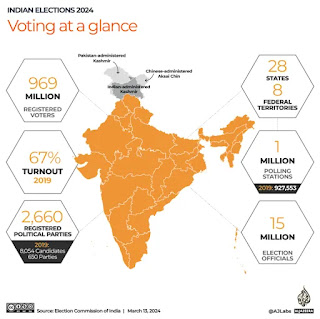 |
| Indian Parliament Buildings in New Delhi |
The results of the biggest elections on Planet Earth are out. And what do they tell us about Indian democracy?
Before we answer that question, it is important to understand why these elections are the biggest.
In 82 days, in 7 phases, 969 million registered voters had to go to over 1 million polling stations to vote. Now, that is no small number.
For perspective, the Indian voting population is greater than all the voters of the USA, Indonesia, Pakistan, Bangladesh, Russia, Mexico, and South Africa put together.
From another perspective, the Indian voters’ number is greater than all the population in all the European countries combined.
 |
| Source : Al Jazeera |
By the end of the day, on 1 June 2024, when elections across India were completed, the total number of voters who eventually turned up to cast their ballot was 642 million,
The 66% voter turnout, from those eligible to vote, is the same percentage of voter turnout that the 2020 US Presidential elections had had. But the US voter turnout was not even 160 million.
 |
| Source : Al Jazeera |
On June 3, the Indian Chief Election Commissioner Rajiv Kumar announced that the voter turnout figure surpasses the combined total voters of the G7 nations by 1.5 times.
So, all of India was waiting for June 4, after 82 days of patience, to hear the election results.
Prime Minister Modi’s political party, Bhartiya Janata Party (BJP), for the third consecutive time, got the greatest number of seats (240 seats) by any political party, but that number was not enough.
The parliament’s lower house (Lok Sabha) has a total of 543 seats, for which people vote. So, any party, or a coalition of parties, with a simple majority of 272 seats, can rule for a 5-year term.
A coalition called the National Democratic Alliance (NDA), which has BJP and some other allied parties in the alliance, can claim 292 seats which the NDA has collectively won; and form the government as a coalition.
Modi would then become the second PM, after Nehru, to become the prime minister of India, for the third time consecutively.
 |
| Source : Al Jazeera |
In his earlier two terms, having won more than the required 272, the BJP - with its 282 seats won in 2014 and with 303 in 2019 - had no real need for any coalition.
The NDA (BJP with its allies) had gotten 336 seats in 2014 and 353 seats in 2019 and, in a way, decimated almost all opposition in the parliament.
Now, in 2024, NDA has won 293 seats and will form the government. And, the INDI Alliance or I.N.D.I.A (Congress Party and its allies) with 234 seats will sit in the opposition benches.
India, as a nation, should be happy with this because finally, a healthy opposition is now a reality.
There were speculations that some parties within NDA, such as Chandrababu Naidu’s Telugu Desam and Nitish Kumar’s Rashtriya Janata Dal (RJD), may defect from the NDA bloc to INDI alliance (I.N.D.I.A).
If that had happened, it could have been a huge power shift in the elections and some confusion. But NDA (BJP and allies) has collectively chosen Modi to lead as the Prime Minister, again.
What does all this tell us?
It tells us that electoral democracy has matured and is thriving in India.
The humongous size of the population, the complexity of religions, castes, and subcastes, the numerous languages, cultures, and customs, the ideological differences of the political parties, and the passionate debates that rage on stages and TV channels are all there. But the citizens of India know that the vox populi will be heard.
The absence of political violence despite fiery speeches, and the acceptance of results by all parties, with no allegations of voter fraud or rigging, shows us one thing. In India, democracy has matured.
There is a new respect for the voice of the people, for the value of the ballot, and for the power of democracy.
- For the PDF file of the newspaper page, CLICK HERE
- For the PDF of the full newspaper (check page 4) of that day, CLICK HERE